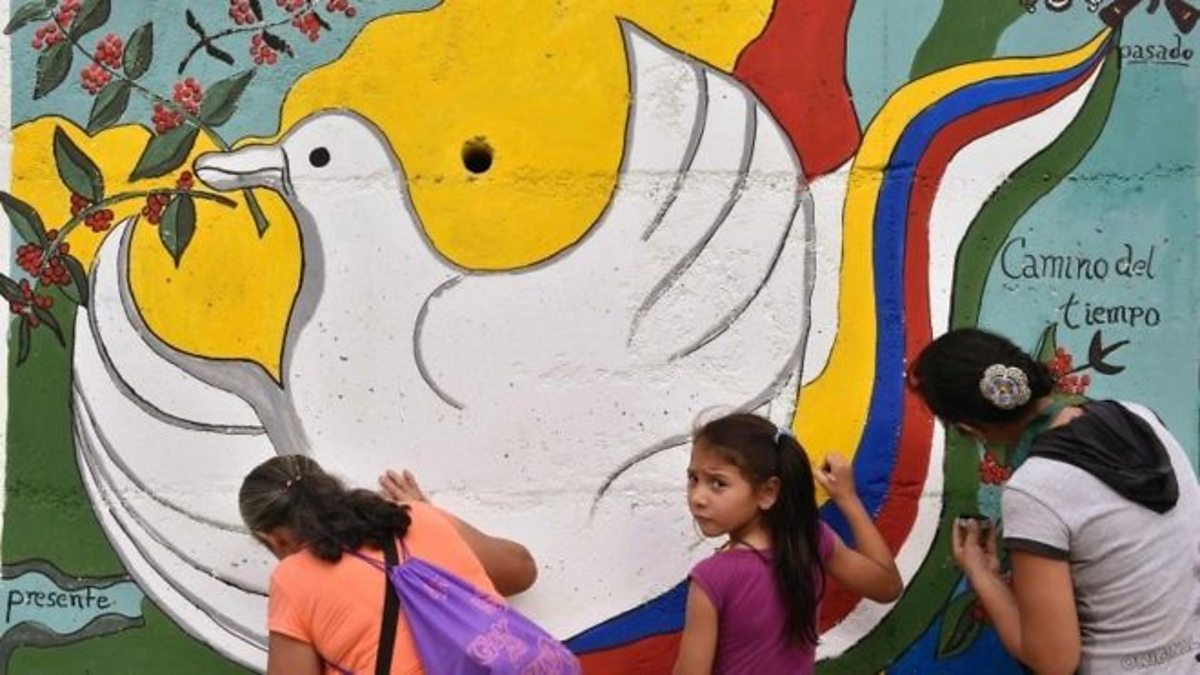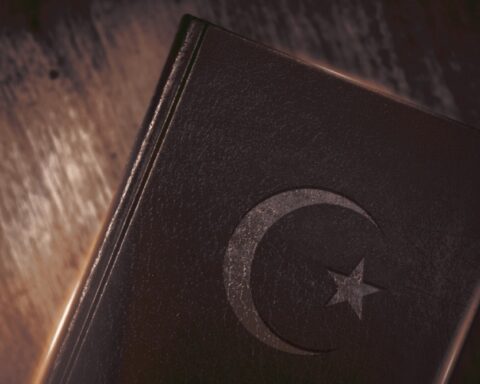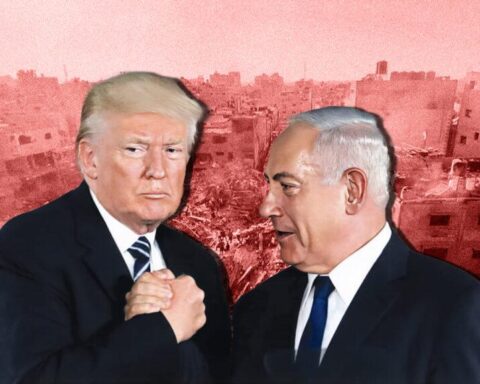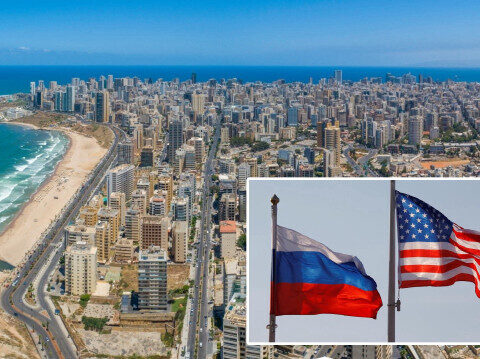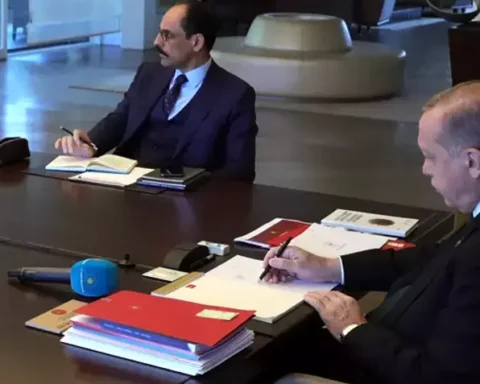“Las balas escribieron nuestro pasado. La educación, nuestro futuro.”
“Bullets wrote our past. Education is our future.”
Ongoing armed conflicts in different parts of the world deeply wound not only military and political balances but also the spirit of societies, their collective memory, and their imagination of the future. The traumas left by these conflicts lead to long-term social fractures that affect not only the current generation but also the generations to come. Therefore, peace processes involve not only the silencing of weapons, but also the reconstruction of societies, the establishment of trust, and the implementation of social justice.
In this context, the peace process that Colombia carried out with the FARC and Türkiye’s own peace initiatives—despite their different historical and cultural contexts—share noteworthy similarities. While Colombia stands out with rural conflict dynamics shaped by over half a century of guerrilla warfare and a drug-based economy, Türkiye presents a much more complex picture defined by ethnic identity, regional inequality, and center–periphery tensions. The IRA, on the other hand, represents another example of the disbandment of armed groups in the social and political spheres, following a protracted struggle marked by sectarian identity conflicts and issues of political representation in Northern Ireland. Nevertheless, the common aspects of these two experiences with the process in Türkiye cannot be overlooked: in these countries as well, discussions on disarmament, the framework of political representation, the depth of social participation, and the role of international actors emerged as critical issues that shaped the future of peace.
In the case of Colombia, delays in promises of rural development and land reform made peace fragile; in Türkiye, the resolution process being conducted behind closed doors weakened social ownership. Similarly, the peace process with the IRA in Northern Ireland required not only disarmament agreements but also the broad societal acceptance of political representation, cultural rights, and justice mechanisms.
At this point, comparative analysis strongly reminds us that peace is not merely a technical agreement between the state and armed actors, but a contract that encompasses the entire society.
The FARC Peace Process in Colombia: Historical Paradoxes
The relationship between the Revolutionary Armed Forces of Colombia (FARC) and the United States is a process fraught with contradictions, stretching from the ideological polarization of the Cold War era to the present day. One of the striking paradoxes in this relationship is that the FARC used American-made weapons for years.
Founded in 1964, the FARC organized around a Marxist-Leninist ideology in response to rural poverty, land inequality, and state repression. The United States, influenced by the Cuban Revolution, viewed the rising leftist movements in the region as a threat and provided military support to the Colombian government. However, the vast arms market in Latin America led to American weapons left over from conflicts in Central America falling into the hands of the FARC through smuggling routes. This created an ironic situation in which weapons supported by Washington were indirectly used by the FARC.
In the 1980s, the FARC increased its armament with revenue from the drug trade. Some of the light weapons sent by the US for “counter-guerrilla” operations in Central America ended up on the black market and reached Colombia. The M-16 rifles, M-60 machine guns, and US-made rocket launchers in the hands of the FARC were the most concrete examples of this paradox. In other words, while the US was providing billions of dollars in military aid to the Colombian government, it was also indirectly fueling the FARC’s war capacity with its own weapons.
Under “Plan Colombia,” implemented in the 2000s, the US provided large-scale military and economic aid to the Colombian army. During this period, American special forces actively advised operations against the FARC. However, the reality on the ground was this: while the weapons pumped in by the US under the guise of fighting drugs circulated on the black market, FARC fighters continued to fight with American-made weapons.
During the Havana Peace Talks that began in 2012, the US supported the Colombian government’s efforts. However, one of the unspoken issues at the table was that the years-long war had been built on a contradiction that fueled both the American arms industry and illegal trade networks. The peace agreement signed in 2016 was welcomed by the US. Nevertheless, the historical irony of the FARC’s struggle with American-made weapons remained one of the most memorable aspects of this relationship.
The peace agreement signed between the Colombian government and the FARC in 2016 aimed to end more than 50 years of internal conflict. This process was seen as a historic turning point because it claimed to bring one of Latin America’s longest-running armed conflicts to an end. The agreement included not only disarmament but also socio-economic transformation measures such as rural development, land reform, and combating drug trafficking. The issue of land reform, in particular, stood out as one of the root causes of the conflict. Since the 1960s, deep inequality between small farmers and large landowners had continuously fueled tension in rural areas and strengthened the FARC’s organizational base.
Following the agreement, FARC members surrendered their weapons under UN supervision. This created great hope in the international community. However, there was a critical detail: although the disarmament process was completed, the “rural development projects” envisaged in the agreement were largely delayed. The state’s failure to implement agricultural reform and infrastructure investments quickly enough made it difficult for former guerrillas to integrate into economic and social life. This vacuum led some former FARC members to join new armed groups called “dissidencia.” In other words, although peace existed on paper, its social foundation could not be fully built in practice.
Although the FARC (Fuerzas Armadas Revolucionarias de Colombia) in Colombia and the PKK (Partiya Karkerên Kurdistanê) in Türkiye emerged on different continents and in different historical contexts, they stand out as two organizations that are frequently compared in terms of their peace processes.
Similarities:
- Both organizations initially defined themselves through armed struggle against social injustices. The FARC emerged with the claim of defending rural land reform and the rights of poor peasants, while the PKK arose with the justification of fighting for the recognition of Kurdish identity and against regional inequalities.
- Over time, both movements evolved into not only ideological and political organizations but also military-strategic forces.
- The FARC and the PKK were both designated as terrorist organizations by the international community for many years, which rendered the legitimacy of their pursuit of political solutions highly controversial.
- Both the FARC and the PKK were directly exposed to the role of international actors during their peace processes: Norway and Cuba acted as guarantors in the FARC process, whereas in the PKK process, observers from Europe were invited—but no formal guarantor mechanism was established.
Differences:
- Social base: While the FARC primarily drew support from peasants in rural areas, the PKK’s social base expanded through Kurdish identity across both rural and urban regions.
- Financial resources: The FARC generated substantial income through drug trafficking and smuggling. The PKK, on the other hand, financed its operations largely through diaspora support, cross-border logistics related to the drug trade, and local resources.
- Symbolism: The FARC aimed to bring about a sociological revolution in Colombia; its goal was not to establish a separate state but to push the existing regime toward socialist transformation. The PKK, however, evolved along a different trajectory; the organization pursued a structure that would first lead to autonomy and then to an independent state through territorial acquisition. This distinction is clearly reflected in the organizations’ symbols. The FARC based its symbol on the Colombian flag, writing its name over it and framing its discourse through national symbols. In contrast, the PKK—whose current flag still features a red background with a yellow circle and a red star in the center—employs visual symbolism that combines ethnic identity and revolutionary ideology. In the PKK’s ideological narrative, the yellow background refers to the geography of “Kurdistan,” the red star to its Marxist-Leninist roots, and the red background to revolutionary struggle. Thus, while the FARC’s symbolism indicates a desire to transform the existing state, the PKK’s symbolism points toward the construction of a non-state structure and separation.
- International context: The FARC’s struggle was linked to post–Cold War leftist movements in Latin America, whereas the PKK’s struggle is embedded in the ethnic, national, and geopolitical dynamics of the Middle East.
- Post-peace integration: After the agreement, the FARC transformed into a political party and became a legitimate actor in Colombian politics. In Türkiye, however, the structures regarded as the PKK’s political representatives (e.g., HDP/DEM) remain in a tense relationship with the state, and full integration of the armed wing has not yet been achieved.
Türkiye’s Peace Initiatives
In Türkiye, the “resolution process” carried out between 2013 and 2015 is perhaps remembered as the most comprehensive initiative. However, unlike the case of Colombia, the process in Türkiye took shape primarily through the lens of security and political negotiation. It is fair to say that the socio-economic dimension—for instance, directly linking regional development projects to political consensus—remained secondary.
Another important issue is that the “alternative peace reports” prepared by local civil society organizations and academics during the resolution process were largely disregarded. In contrast, hundreds of civil society representatives in Colombia were included in the Havana negotiations as observers or advisors. In Türkiye, the process was conducted mostly behind closed doors, which weakened social ownership.
Istanbul, Havana, and Belfast
- Istanbul: A Missed Historical Opportunity
The 10-point agreement announced at Dolmabahçe Palace in 2015 represented the most concrete roadmap for resolving the Kurdish issue in Türkiye. The points included critical themes such as democratization, recognition of identity rights, disarmament, and social participation. However, the political atmosphere changed sharply in a short time. Electoral dynamics in domestic politics, the Syrian crisis in foreign policy, and increasing security concerns made it impossible for the agreement to be embraced.
Some factions within the state labeled the agreement as a “wrong” step and questioned the legitimacy of the process. The conflicts that followed Dolmabahçe exposed the fragility of the process. Today, the Dolmabahçe Agreement remains remembered as a “missed opportunity for peace” and lives on as a symbol reminding us how vital social participation and political will are in Türkiye’s pursuit of peace.
- Havana: Institutionalized Dialogue
In Colombia, the negotiations between the government and the FARC concluded in a peace agreement in 2016 after years of talks in Havana. The most distinctive feature of the Havana process was the strong international guarantee mechanism: Norway and Cuba played active roles, and the United Nations also participated as an observer.
In addition, the broad participation of civil society was one of the most defining aspects of the process. Hundreds of representatives from civil society organizations, academics, relatives of victims, and human rights defenders were directly involved in the negotiations. For this reason, the signed document was not merely a political bargain between the government and the organization—it also constituted a broad social contract.
Nevertheless, the Colombian example also shows us this: signing a peace agreement alone does not guarantee lasting peace. The delays in land reform and rural development projects that were envisioned after the agreement gave rise to new risks of conflict. Some FARC factions, under the name “dissidencia,” refused to disarm, and violence reemerged in various regions. This clearly demonstrated how implementation shortcomings can undermine peace.
- Belfast: The Good Friday Agreement
Signed in 1998, the Good Friday Agreement was the result of negotiations between the IRA, the United Kingdom, and the Republic of Ireland, and is considered one of the most successful examples of modern peace processes. Two fundamental aspects made this process strong:
- Cross-guarantee: Both London and Dublin signed the agreement, becoming guarantors of peace. This provided mutual trust between the parties in Northern Ireland.
- Public referendum: The agreement was submitted to a vote by the people of Northern Ireland and was approved by a large majority. Thus, peace became not only the product of the political elite but also of the will of the people.
The Good Friday Agreement largely ended the armed conflict and laid the foundation for a new political order. The power-sharing model ensured political representation for both Catholic and Protestant communities. Additionally, police reform, the strengthening of human rights mechanisms, and economic support programs were integral parts of the agreement.
Although political deadlocks and social tensions still occasionally arise in Northern Ireland today, the 1998 agreement remains a historical turning point in the transformation of conflict into a “sustainable peace.”
Türkiye’s Peace Process with the PKK Today: Current Situation, Shortcomings, and Requirements
Türkiye’s conflict with the PKK has remained one of the most critical issues in terms of both domestic politics and social peace for more than forty years. After the failure of the resolution process conducted between 2013 and 2015, security-oriented policies came to the forefront, and peace initiatives were shelved for a long time. However, as of 2025, new developments have marked a notable turning point in the course of this process.
- Current Situation
At the beginning of 2025, MHP leader Devlet Bahçeli called for disarmament, followed by Abdullah Öcalan’s statements regarding the burning of weapons and the dissolution of the organization. This was solidified with the PKK’s declaration of a ceasefire and, in May, a decision announced at the organization’s congress to end the armed struggle. These developments have sparked significant hope for an end to the decades-long conflict.
The “National Solidarity, Brotherhood, and Democracy Committee” established in the Grand National Assembly of Türkiye has provided an institutional framework for the process, and the inclusion of representatives from various political parties has enhanced the legitimacy of the search for peace. The reduction of cross-border clashes in the Kurdistan Region of Iraq and in Syria has also raised expectations for regional stability.
- Shortcomings
Nevertheless, the peace process still rests on fragile ground. First and foremost, insufficient steps have been taken to build public trust. Despite calls for disarmament, ongoing operations against individuals and institutions associated with the organization weaken the ceasefire’s effectiveness on the ground.
Civil society organizations, academia, and women’s and youth organizations have not been sufficiently included in the process. The lack of democratic reforms, the inadequacy of the current constitution, the failure to guarantee cultural rights, and the disconnection of regional development projects from peace policies undermine social ownership. Furthermore, the lack of transparency in the process fuels public suspicion.
- Requirements
To achieve lasting peace, it is essential to move beyond security-centered policies. First, transparent and independent mechanisms must be established for disarmament and the integration of organizational cadres into society, and international observers must be involved in the process in accordance with Türkiye’s societal dynamics.
Effective participation of civil society, local administrations, and various social groups in the peace process must be ensured. Democratic reforms must be implemented to build trust in the areas of freedom of expression, political representation, and cultural rights. Regional development projects should be directly linked to the peace process in order to address economic inequalities and enhance social welfare.
Finally, transparency and accountability should be prioritized at every stage of the process, and reconciliation and justice mechanisms must be established to address past grievances.
“Dissidencia”
In the disbandment of armed organizations, dissidencia—that is, division, breakaway, and resistance within the organization—constitutes one of the most critical thresholds. In the case of the PKK, the tension between those who lay down arms and those who resist doing so is not merely an internal organizational issue; it is also a process that tests society’s capacity to integrate with peace and measures the resilience of the social fabric.
In this context, the most important task is to strike a balance between justice and compassion. It is essential that legal responsibilities are not overlooked when reintegrating those who disarm into society; however, if this process relies solely on a punitive approach, the re-radicalization of individuals becomes inevitable. Instead, a restorative justice approach should be adopted—one that allows individuals to confront their crimes while also facilitating mechanisms that help them reconnect with society. In doing so, a sense of belonging is reinforced for individuals, and the culture of peace can become permanent.
Another necessity is socio-economic integration. Education, employment, and psychosocial support programs are prerequisites for enabling those who disarm to build a new life. The absence of such support may lead dissidencia to experience social exclusion and a return to violence. In this regard, establishing mechanisms for social dialogue and testimony is also critically important. The testimonies of those who have disarmed not only offer an opportunity to confront the past, but also contribute to the creation of a shared language of peace for the future.
The integration process also requires an inclusive approach that does not discriminate. Developing specific programs for women, youth, and former members from different identities ensures that the peace process proceeds on an equitable basis. This inclusivity both strengthens the sense of trust and prevents the emergence of a “secondary dissidencia” within society.
On the other hand, actions that should not be taken are just as important as those that should. Collective punishment and stigmatization cause disarmed individuals to be perceived as a “potential threat,” which feeds societal prejudice and may push individuals back toward violence. Similarly, dismissing groups that refuse to disarm as merely “marginal” elements paves the way for the conflict to persist in new forms.
It is also a major mistake to emphasize only security measures in the integration process. Military and police interventions, while possibly providing short-term stability, undermine the development of a peace culture and render the spirit of the process impossible. Furthermore, if the opportunities granted to those who disarm are structured in a way that overshadows victims’ pursuit of justice, it creates a deep crisis of justice in society. Restorative justice mechanisms should play a balancing role at this point, making the voices of victims a fundamental component of peace.
Ultimately, the dissidencia process is not only an indicator of individual transformation, but also of societal reconstruction. The success of this process is not possible through a security-centered lens, but through the principles of justice, compassion, inclusivity, and transparency. In the PKK case as well, the integration of both those who lay down arms and those who resist doing so can only lay the foundations for lasting peace if guided by these principles.
International Influence and Internal Dynamics
In the Colombian peace process, countries such as Norway and Cuba assumed the role of guarantors, thereby securing the legitimacy and continuity of the negotiations on an international level. In Türkiye, however, no such international guarantee mechanism was ever implemented in the past; instead, the search for peace was largely conducted under the shadow of internal political balances. A similar situation applies to the peace process that restarted in 2025: the success or failure of the process appears to depend directly on Türkiye’s internal political dynamics, the strategic positions of the ruling and opposition parties, and the extent to which society embraces peace.
Within this framework, the opportunities offered by the process for Türkiye are noteworthy. First and foremost, the PKK’s decision to lay down arms has the potential to strengthen the domestic security environment, thereby opening up broader space for economic development and democratization. At the same time, this development strengthens Türkiye’s position in the field of regional diplomacy, fostering the image of a peaceful actor in its relations with Iraq, Syria, and Europe. Moreover, ending the conflict at a societal level could pave the way for the development of a new culture of political participation by enhancing the capacity of diverse identities to coexist.
On the other hand, the process also contains serious threats. The absence of international guarantors leaves the establishment of trust between parties solely dependent on mutual declarations of goodwill, making the process fragile. The dominance of short-term political calculations in domestic politics increases the risk of instrumentalizing peace-related steps. Furthermore, dissidencia from groups refusing to disarm may persist as a constant threat to the security dimension of the process. Issues related to societal perceptions of “justice,” the marginalization of victims’ voices, or a lack of transparency also hold the potential to weaken public support for the peace process.
At this point, the Northern Ireland example is highly instructive: in the peace process with the IRA, international actors (such as the US and the EU) played an active facilitating role and helped establish mechanisms to alleviate mutual distrust between the parties. Moreover, ensuring social participation—especially amplifying the voices of victimized communities—contributed to the durability of peace.
The peace process that began in 2025 offers Türkiye a historic opportunity, but it is also surrounded by serious threats that could lead to this opportunity being squandered. Its success depends not only on the determination of the political leadership but also on a committed effort to strengthen social participation, increase transparency, and take inclusive steps toward building trust.
Social Contract
These three experiences clearly show us that peace is not merely the moment when weapons fall silent; it is also a long, difficult, and painful process of social transformation. If this transformation is not supported by social participation, it becomes almost inevitable that weapons will start speaking again. In Colombia, the lack of rural development, and in Türkiye, the lack of social participation, have emerged as the most apparent vulnerabilities threatening the sustainability of peace.
Building peace is not just a protocol signed at a table; it is a social contract that is produced in the streets, villages, schools, universities, unions, and parliaments. A peace process that does not include all segments of society and is managed solely by the political elite resembles not a live birth but a stillbirth. The absence of participation is a deficiency that suffocates peace before it is even born; any initiative that fails to include the voice, pain, and demands of the people may offer short-term hope, but in the long run, it becomes the foundation for renewed conflict.
The examples of Colombia, Northern Ireland, and Türkiye leave us with a clear lesson in this regard: Peace is a process that must be nurtured by the collective will of the entire society, beyond the negotiations between the state and the organization. If this will and participation are not achieved, the name of peace may live on, but its spirit will already be lost.

